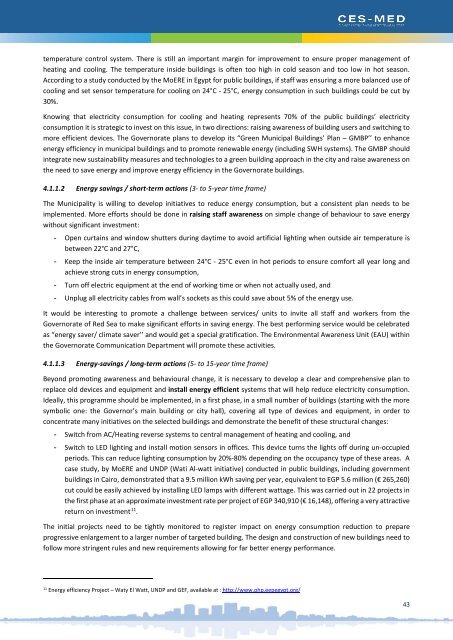020318_Hurghada SECAP_FINAL
You also want an ePaper? Increase the reach of your titles
YUMPU automatically turns print PDFs into web optimized ePapers that Google loves.
temperature control system. There is still an important margin for improvement to ensure proper management of<br />
heating and cooling. The temperature inside buildings is often too high in cold season and too low in hot season.<br />
According to a study conducted by the MoERE in Egypt for public buildings, if staff was ensuring a more balanced use of<br />
cooling and set sensor temperature for cooling on 24°C - 25°C, energy consumption in such buildings could be cut by<br />
30%.<br />
Knowing that electricity consumption for cooling and heating represents 70% of the public buildings’ electricity<br />
consumption it is strategic to invest on this issue, in two directions: raising awareness of building users and switching to<br />
more efficient devices. The Governorate plans to develop its “Green Municipal Buildings’ Plan – GMBP’’ to enhance<br />
energy efficiency in municipal buildings and to promote renewable energy (including SWH systems). The GMBP should<br />
integrate new sustainability measures and technologies to a green building approach in the city and raise awareness on<br />
the need to save energy and improve energy efficiency in the Governorate buildings.<br />
4.1.1.2 Energy savings / short-term actions (3- to 5-year time frame)<br />
The Municipality is willing to develop initiatives to reduce energy consumption, but a consistent plan needs to be<br />
implemented. More efforts should be done in raising staff awareness on simple change of behaviour to save energy<br />
without significant investment:<br />
- Open curtains and window shutters during daytime to avoid artificial lighting when outside air temperature is<br />
between 22°C and 27°C,<br />
- Keep the inside air temperature between 24°C - 25°C even in hot periods to ensure comfort all year long and<br />
achieve strong cuts in energy consumption,<br />
- Turn off electric equipment at the end of working time or when not actually used, and<br />
- Unplug all electricity cables from wall’s sockets as this could save about 5% of the energy use.<br />
It would be interesting to promote a challenge between services/ units to invite all staff and workers from the<br />
Governorate of Red Sea to make significant efforts in saving energy. The best performing service would be celebrated<br />
as “energy saver/ climate saver’’ and would get a special gratification. The Environmental Awareness Unit (EAU) within<br />
the Governorate Communication Department will promote these activities.<br />
4.1.1.3 Energy-savings / long-term actions (5- to 15-year time frame)<br />
Beyond promoting awareness and behavioural change, it is necessary to develop a clear and comprehensive plan to<br />
replace old devices and equipment and install energy efficient systems that will help reduce electricity consumption.<br />
Ideally, this programme should be implemented, in a first phase, in a small number of buildings (starting with the more<br />
symbolic one: the Governor’s main building or city hall), covering all type of devices and equipment, in order to<br />
concentrate many initiatives on the selected buildings and demonstrate the benefit of these structural changes:<br />
- Switch from AC/Heating reverse systems to central management of heating and cooling, and<br />
- Switch to LED lighting and install motion sensors in offices. This device turns the lights off during un-occupied<br />
periods. This can reduce lighting consumption by 20%-80% depending on the occupancy type of these areas. A<br />
case study, by MoERE and UNDP (Wati Al-watt initiative) conducted in public buildings, including government<br />
buildings in Cairo, demonstrated that a 9.5 million kWh saving per year, equivalent to EGP 5.6 million (€ 265,260)<br />
cut could be easily achieved by installing LED lamps with different wattage. This was carried out in 22 projects in<br />
the first phase at an approximate investment rate per project of EGP 340,910 (€ 16,148), offering a very attractive<br />
return on investment 11 .<br />
The initial projects need to be tightly monitored to register impact on energy consumption reduction to prepare<br />
progressive enlargement to a larger number of targeted building. The design and construction of new buildings need to<br />
follow more stringent rules and new requirements allowing for far better energy performance.<br />
11<br />
Energy efficiency Project – Waty El Watt, UNDP and GEF, available at : http://www.php.eepegypt.org/<br />
43

















